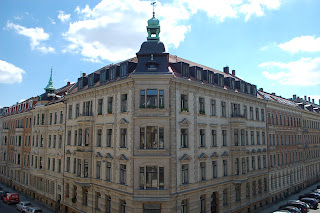I am so glad I have friends who live and work in Leipzig! The city has amazing history and culture, and I was able to partake in both with great success.
I was so happy to meet up with Susanne and Jurgen again, and they treated me with such hospitality and it made the sojourn extra special.
After arriving, Susanne and I took in the Museum der Runde Ecke – the exhibition on the Stasi’s activities in the Leipzig area from 1950 through the Peaceful Revolution of Fall 1989.
 The exhibits were set up within two years of the collapse of the DDR and the Stasi, and there is an atmosphere of urgency to remember and document the sordid treatment of fellow citizens.
The exhibits were set up within two years of the collapse of the DDR and the Stasi, and there is an atmosphere of urgency to remember and document the sordid treatment of fellow citizens.We also viewed the “Wie sind das Volk” exhibit focusing on the “Peaceful Revolution” for which Leipzig is well known.
The Peaceful Revolution using candles and prayers began in 1981 to protest the anticipated deployment of cruise missiles in West and East Germany. The focus expanded in 1982 to include free elections. The citizens met every Monday at 5pm to pray and light candles.
By 1988, the numbers of citizens involved in the prayerful protest grew. They began to demonstrate Kein Gewalt (without violence) and march to the Stasi headquarters to state their demands. By October 1989, tens of thousands participated each Monday, and as the weeks progressed, more and more people joined the peaceful demonstrations. By late October, the numbers grew to several hundred thousand.
The participants also of the destruction of the “Reichspogromnacht” – Kristallnacht – 50 years later. The numbers neared 250,000, and the marchers took to the streets that ring the city center, the main focus again was the Stasi Headquarters and the demands were for Democracy, Free Elections, and non-violence.
They purposely chose to carry candles, one hand to hold the taper and the other to protect the flame, to clearly show they held no weapons and their intentions were non-violent. The exhibit was so inspiring and uplifting and I am so glad to attended the museum.
We also took coffee at the Kaffe Baum and Coffee museum! Delicious coffee and interesting exhibits on the history of coffee in general, and especially on the role coffee played in Leipzig’s history and culture.
More walking through the beautiful streets and Hofs - warehouses and passageways for markets in earlier decades and centuries.
Later we dined in the same cellar cafe where Goethe ate and included the location for a scene from Faust. Anbed visited Thomaskirche where Bach was the music master, as well as Nikolaikirche where the Peaceful Revolution met for prayers each Monday.
 We also visited the denkmal - memorial to the Battle of the Nations in which Napoleon was defeated after his retreat from Moscow. It is a large and stark memorial.
We also visited the denkmal - memorial to the Battle of the Nations in which Napoleon was defeated after his retreat from Moscow. It is a large and stark memorial. I enjoyed the time in Leipzig and will definitely return for more history, culture and my dear friends!























































